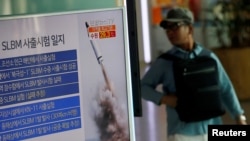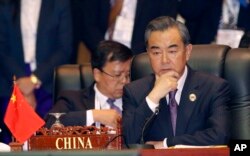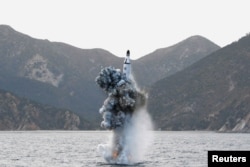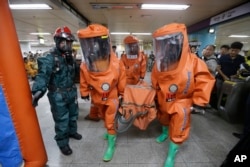North Korea’s latest submarine-launched ballistic missile (SLBM) test demonstrated real progress in advancing the military’s ability to launch a nuclear strike on the U.S. mainland or any other target in the world.
The missile, fired from near the coastal city of Sinpo early Wednesday morning, travelled about 500 kilometers before falling into the sea inside Japan’s air defense identification zone (ADIZ).
Japanese Prime Minister Shinzo Abe called the North Korean provocation an “unforgivable act” in “obvious defiance of U.N. Security Council resolutions.”
"This is the first time that North Korea's missile landed in Japan's air defense identification zone. This poses a grave threat to Japan's security, and is an unforgivable act that damages regional peace and stability markedly,” said Abe.
The foreign ministers from China, Japan and South Korea discussed the North’s missile launch during a trilateral meeting in Tokyo on Wednesday.
While the diplomats from Tokyo and Seoul forcefully condemned Pyongyang’s actions, Beijing’s Foreign minister Wang Yi focused on fostering broader cooperation.
"It's our responsibility to promote economic development, lead regional cooperation and maintain regional peace and stability," he said.
Progress
North Korea is considered to be in the early stages of developing submarine based missile launch capability.
Pyongyang claimed to have conducted its first successful SLBM test in May of 2015, but analysts later determined the missile was launched from an underwater barge and not from a submarine.
In December of 2015, the North test-fired an SLBM that reportedly exploded in midair after traveling for a few kilometers.
North Korea’s last submarine missile test, in April, travelled only 30 kilometers before falling into the sea.
The South Korean military said Wednesday’s launch, of what it presumed to be a KN-11 midrange SLBM, indicated a real advancement of the North’s ballistic missile capability.
“Over the past year or two they have been making rapid progress. I think this progress is faster than most people have expected,” said security analyst Daniel Pinkston with Troy University in Seoul.
Joshua Pollack, editor of the U.S.-based Nonproliferation Review, noted that only six countries including the United States, Russia and China have mastered SLBM technology.
While North Korea claims to have developed a miniature nuclear device to attach to a ballistic missile, it has not yet demonstrated that capability.
Submarine fleet
North Korea currently maintains one of the world's largest submarine fleets, with approximately 70 underwater vessels.
Most of the these submarines are old, built with 1950s technology and powered by diesel-electric engines, which means they can only stay submerged and hidden from radar for a few days at a time.
But since Kim Jong Un came to power in 2011, the North Korean military has accelerated efforts to modernize its submarine fleet, according to Jane’s Intelligence Review, a global security journal.
Joint exercises
South Korea’s Foreign Ministry denounced the latest missile test in a statement and condemned the continuing provocations by the North, “including nuclear tests and launches of ballistic missiles, ignoring repeated warnings of the international society and violating resolutions of the U.N. Security Council.”
The North’s SLBM test was also likely timed to protest the annual South Korean and American joint military exercises currently underway.
About 25,000 U.S. forces and 50,000 South Korean troops are involved in the two-week Operation Ulchi Freedom exercise, which is largely simulated.
“One of the objectives of the SLBM test is to rattle Seoul and Washington and their allies and to throw the exercises off track,” said Pinkston.
UN
The U.S. military’s Pacific Command also issued a statement condemning the North’s missile test, saying the U.S. “intends to raise our concerns at the U.N. to bolster international resolve in holding the DPRK accountable for these actions.”
North Korea’s continued and repeated ballistic missile tests violate United Nations resolutions banning the country from developing nuclear weapons and ballistic missile technology.
The United Nations Security Council imposed harsh sanctions on North Korea in March for its fourth nuclear test and long range rocket launch earlier this year.
But the 15-member Security Council, which includes the U.S., China and Russia, met in July after North Korea launched three land based missiles and were unable to agree to issue an official denouncement.
Beijing’s reported reluctance to further reprimand Pyongyang may be related to its increasingly strained relations with Seoul and Washington over the deployment of the American THAAD missile defense system in South Korea.
Youmi Kim in Seoul contributed to this report.













